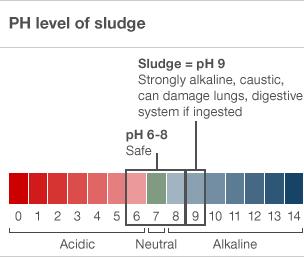How toxic is Hungary's red sludge?
- Published

The chemical spill has left a trail of devastation over 40 square kilometres
A toxic spill of red sludge has cascaded through dozens of villages in Hungary, killing seven and injuring scores.
The sludge, which contains a mix of metal oxides, is now making its way towards the Danube, Europe's second-longest river.
But what exactly is the sludge, and how hazardous is it to humans?
The sludge is a by-product from the early stage of aluminium production, which leaked from storage reservoirs.
As part of the process, bauxite, the raw material, is taken out of the ground and washed with sodium hydroxide.
This produces alumina, which is processed further, and waste, which is composed of solid impurities, heavy metals, and the chemicals used as processing agents.
'Burns and irritation'
About 40%-45% of the waste is iron-oxide, which gives it the red colour.
Another 10%-15% is aluminium oxide, a further 10%-15% silicon oxide and there are smaller quantities of calcium oxide, titanium dioxide and sodium oxide, according to MAL Hungarian Aluminium, the company that owns the Ajkai plant.

Professor Paul Younger from the Newcastle Institute for Research on Sustainability at Newcastle University says the "fundamental problem is that it has a tendency to be strongly alkaline".
In the most concentrated areas, he says, it could be compared to products you would clean your kitchen with, causing dry or cracked skin, or - in cases of prolonged contact - it can "lift off the top layer of your skin".
Scores of people have already suffered burns in affected areas, with at least 120 receiving treatment.
"If you get it in your eyes it is also not good news," he adds.
Experts say the effects are only more serious if the substance is ingested, when it can cause damage to lungs and the digestive system, and could prove fatal in some cases.
Cancer link?
But what about the presence of heavy metals: are they dangerous?
Some studies have linked the inhalation of titanium dioxide and silicon dioxide dust to cancer in animals, but it has not been proven in humans.
But Prof Younger says the quantity of these substances is far too small to cause any harm.
"Typically the concentrations are small in red mud and what is present is tightly bound to the particles of iron oxide," he says.
"It's not a 'we're all going to die' scenario. It's not like a big cyanide spill," he says.
Dr John Hoskins, a consultant toxicologist, says that while the initial spill was quite dangerous, there should not be any long-term impact on human health as long as the waste is cleaned up.
"It will be neutralised by nature, because of rain which will dilute it and because of the chances that it will come into contact with slightly acidic substances in soil... but that will take a little time," he says.
For humans, he says, "the danger would essentially be in ingestion, which is unlikely".
"You are not going to pick it up and eat it."
Fishing ban
The problem at the moment is the "heavy metal residue", as it is a danger for plant life and can get into rivers, he says.
He says that while it is unlikely that residents will be using the river directly for drinking water, it may pose a problem for water companies.
There are "real concerns" about the impact on the Danube, he says, as "it will increase the heavy metal content of the water and it might have adverse effects on fish".
Timea Petroczi, a spokesperson from disaster relief services in Hungary, told AFP that people had been told not to use the wells, as a "precautionary measure".
Those in affected areas have also been banned from eating home-grown foods, and from hunting or fishing.
Countries bordering the Danube have reinforced water quality controls and are monitoring the concentration of heavy metals.
Meanwhile, officials are treating affected areas with chemicals - such as calcium and magnesium nitrates - to try to counter the alkaline effects, amid hopes that what is being described as Hungary's worst chemical accident will soon come to an end.
- Published6 October 2010
- Published5 October 2010